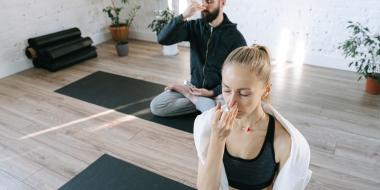Did you know that the average person takes 17 to 23 thousand breaths a day? Breathing is not something people think about; it's an automatic process that happens subconsciously. If we had to think about breathing, we wouldn't have time to think about anything else.
LIFE-SUSTAINING
Breathing is necessary for our survival. Our breath delivers oxygen to our red blood cells, which then circulates throughout the body to our muscles and organs. We typically breathe in oxygen, nitrogen, and carbon dioxide, along with other gases. When we breathe out, we remove toxins and other gases our body doesn't need anymore.
BREATHING EXERCISES
We can use our breath to relax our muscles, reduce pain, lower our heart rate, decrease anxiety, and so much more.
When we are in pain or feeling stressed or anxious, we tend to breathe very shallowly into our chest. This is a problem for many reasons, but the main ones are that we have less oxygen getting into the body and circulating, we tend to overuse our neck and chest muscles (which ends up causing headaches and neck pain), and our diaphragm weakens over time. Our diaphragm is a core muscle that we need to keep strong, which actually helps to decrease both neck and back pain while reducing inflammation.
Diaphragmatic breathing (i.e., deep belly breathing) allows us to breathe deeply and move our body from a stressful state (sympathetic state) to a restful state (parasympathetic state). You can practice diaphragmatic breathing at any time—when you are in pain, feeling anxious or stressed, or just as part of your morning or evening routine, as long as it feels safe to do so. It can take as little as 30 seconds or a minute of breathwork to feel a difference. During deep breathing exercises, make sure that you have good posture. This will ensure that the entire respiratory system can allow for airflow freely, letting in as much oxygen as possible and allowing the diaphragm to fully relax and contract. If you combine breathing exercises with another activity, such as yoga or meditation, you can gain even more health benefits. However, be careful if you start to feel light-headed or dizzy. Take a break and sit or lie down on the floor until the dizziness subsides.
Another breathing exercise you can try is box breathing to help with relaxation and pain. This follows a simple pattern that’s easy to remember: four seconds inhale, four seconds hold, four seconds exhale, and four seconds hold—repeat for as long as you need to.
GREAT FOR PAIN
You can also use your breath to activate the vagus nerve, which can increase relaxation and help decrease pain, inflammation, and muscle tension. This breathing is a bit different than box breathing; typically, you want your exhale to be twice as long as your inhale (so if you inhale for four seconds, exhale for eight seconds).
When we feel a lot of pain, we instinctively hold our breath. This increases pressure inside our bodies and can actually cause damage—specifically to the discs in our spine. This is also true with workouts or doing strenuous activity and lifting something at the same time. Breathing out while doing a strenuous activity is safer and may help reduce your pain.

DON’T BE A MOUTH BREATHER
You’ll also want to make sure that you are breathing through the nose rather than the mouth. Breathing through the nose is important for many reasons. It helps to regulate our nervous system, reduce anxiety, increase a sense of calm, regulate our body temperature, filter out things in the air that shouldn’t go into our lungs, increase the strength of our lungs and heart, stimulate parts of the autonomic nervous system and brain that are associated with smell, increase oxygen uptake, decrease dehydration, reduce jaw pain, affect blood pressure, and reduce the risk of sleep apnea or snoring in general, just to name a few benefits.
Pro tip: Make sure the air that you are breathing is clean. Use an air purifier and be sure to change your filters as recommended. Try to avoid fragrances that are found in perfumes, air fresheners, and cleaning products, as they may cause you irritation. Rather, opt for some lavender essential oil when doing your breathing exercises, which may also help create a calm and relaxing environment to further reduce pain, inflammation, and muscle tension.
Devices such as smartwatches or rings can monitor your breathing and heart rate, and even report your heart rate variability (HRV), which is a health indicator that can be influenced by your breathing.
Breathing is a powerful tool; so, the next time you are feeling stress, anxiety, or pain, just breathe it away.
You May Also Like: 3 Ways to Breathe Mindfully, Holistic Remedies for Anxiety and Stress Relief, How Can You Tell the Difference Between Stress and Anxiety?






